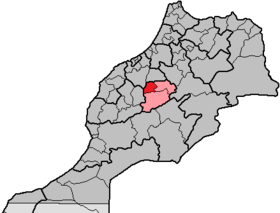Fquih Ben Salah (Province)
The province of Fquih Ben Salah ( Arabic : إقليم الفقيه بن صالح) has an area of about 3250 km² and about 450,000 inhabitants and has been part of the Béni Mellal-Khénifra region (previously Tadla-Azilal ) in central Morocco since 2015 . The capital of the province is the city of the same name, Fkih Ben Salah .
geography
location
The province of Fquih Ben Salah borders in the south with the province Azilal , in the west with the province El Kelaâ des Sraghna , in the north-west with the province Settat , in the north with the province Khouribga and in the east with the province Beni Mellal . The major cities of Casablanca and Marrakech are located around 170 km northwest and 180 km southwest, respectively.
landscape
The province of Fquih Ben Salah is located in the fertile and agriculturally intensively used Tadla Plain at an average altitude of around 450 m .
climate
The daytime temperatures are between 30 and 40 ° C in summer and around 20-25 ° C in winter. At night they drop to 5 to 15 ° C, depending on the season and cloud cover. Outside of the four winter months (November to February) there is hardly any precipitation.
history
The region has never played a significant role in Moroccan history - its capital was nothing more than a larger market town until the early 20th century, which, however, grew steadily through immigration during the colonial period, but especially since the independence of Morocco. The province of Fquih Ben Salah was only created in 2009 by splitting off from the province of Beni Mellal.
population
The majority of the population of the city and the province of Fquih Ben Salah is of Berber origin, but Moroccan-Arabic is mostly spoken on a daily basis . The population has more than doubled since the 1970s, the main reason being the climatic and socio-cultural migration from the countryside .
economy
Most of the inhabitants of the province, untouched by tourism, work in agriculture, which is dominated by the cultivation of grain and olives as well as fruit and vegetable crops - either as independent small farmers or as day laborers in large companies. In addition, craft and retail trade play an important role in the economic life of the province. Many men have emigrated to the metropolises in northwestern Morocco and regularly send their families some money.
Municipalities
The municipalities in the province as self-governing bodies of the local community are shown in the table below with the number of inhabitants. Only the first three municipalities are classified as urban settlements (M = commune municipal ); a further 13 municipalities are considered rural communities ( communes rurales ) and consist of a large number of villages. The spelling of the municipalities according to the 2004 review differs in some cases from the spelling in Décret no 2-09-320 du 11 juin 2009 fixant la liste des cercles, des caïdats et des communes urbaines et rurales . A different spelling in the decree is added in brackets.
| local community | Residents | |
|---|---|---|
| 2nd September 1994 | September 2, 2004 | |
| Fkih Ben Salah (M) | 74,697 | 82,446 |
| Oulad Ayad (M) (Ouled Ayad) | 18,958 | 21,466 |
| Souk Sebt Oulad Nemma (M) | 40,339 | 51,049 |
| Al Khalfia (Khalfia) | 14,496 | 14,341 |
| Bni Chegdale | 12,885 | 11,582 |
| Bni Oukil | 15,249 | 14,960 |
| Bradia | 35,416 | 36,307 |
| Dar Ould Zidouh | 26,885 | 27,615 |
| Had Boumoussa | 39,990 | 41,731 |
| Hel Merbaa | 12,014 | 12,614 |
| Krifate | 32,336 | 34,103 |
| Oulad Bourahmoune (Ouled Bourahmoune) | 14,041 | 13,635 |
| Oulad Nacer (Ouled Nacer) | 26,508 | 26,527 |
| Oulad Zmam (Ouled Zmam) | 33,732 | 31,905 |
| Sidi Aissa Ben Ali | 21,970 | 22,697 |
| Sidi Hammadi | 14,109 | 14,535 |
Attractions
In the entire province there are neither scenic nor culturally interesting sights.
Individual evidence
- ↑ Spelling of the municipalities after: Communes & villes du Maroc
- ↑ Population statistics of the municipalities, sorted by provinces ( Memento from March 3, 2016 in the Internet Archive )
- ↑ Bulletin officiel du Royaume du Maroc, no 5744 18 June 2009, p. 1018–1036 Page 60 of the PDf file 5063 kB
